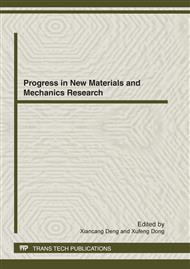[1]
V. P. Makhniy, M. M. Slyotov, V. V. Gorley, Band structure investigations of GaN films using modulation spectroscopy, Appl. Surf. Sci. 253(2006) 246-248.
DOI: 10.1016/j.apsusc.2006.05.075
Google Scholar
[2]
Jielei Wang, Optical Properties of In1-xGaxN Epilayers Grown by HPCVD, Physics and Astronomy Theses Paper, 9( 2010).
Google Scholar
[3]
T L Tansley, C P Foley, Optical band gap of indium nitride, J. Appl. Phys. 59(1986) 3241-3244.
DOI: 10.1063/1.336906
Google Scholar
[4]
B Monear, P P Paskova and A Kasic, Optical properties of InN-the bandgap question. Superlattices and microsturctures, 38(2005) 38.
DOI: 10.1016/j.spmi.2005.04.006
Google Scholar
[5]
Su-Huai Wei and Alex Zunger, Valence band splittings and band offsets of AlN, GaN, and InN, Appl. Phys. Lett. 69 (18) 2719.
DOI: 10.1063/1.117689
Google Scholar
[6]
C. Stampfl, Density-functional calculations for III-V nitrides using the local-density approximationg and the generalized gradient appproximation, Phys. Rev. B. 59(1999) 5521.
DOI: 10.1103/physrevb.59.5521
Google Scholar
[7]
Patrick Rinke, M. Winkelnkemper, et al, Consistent set of band parameters for the group-III nitrides AlN, GaN, and InN, Phys. Rev. B. 77(2008)075202.
DOI: 10.1103/physrevb.77.075202
Google Scholar
[8]
Man-Yi Duan, Structural, electronic, and optical properties of wurtzite and rocksalt InN under pressure, Phys. Rev. B 81(2010)033102.
Google Scholar
[9]
J. W. L. Yim, Effects of surface states on electrical characteristics of InN and In1−xGaxN, Phys. Rew. B 76(2007) 041303.
Google Scholar
[10]
R E Jones, Evidence for p-Type Doping of InN, Phys. Rev. Lett. 96(2006)25505.
Google Scholar
[11]
P. A. Anderson, C. H. Swartz and D. Carder, et al, Buried p-type layers in Mg-doped InN, Appl. Phys. Lett. 89(2006) 184104.
DOI: 10.1063/1.2378489
Google Scholar
[12]
Ding Shaofeng,Research on First Principles of Nitriding Indium p Type Doping, Journal of Physics, 56 (2007) 4062.
Google Scholar
[13]
Dong Chengjun, Calculation on First Principles of Electronic Structure and Optical Property of Doping InN in Si, Journal of Sichuan Normal University, 6(2009) 781.
Google Scholar


